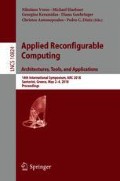Abstract
Deep convolutional neural networks have dominated the pattern recognition scene by providing much more accurate solutions in computer vision problems such as object recognition and object detection. Most of these solutions come at a huge computational cost, requiring billions of multiply-accumulate operations and, thus, making their use quite challenging in real-time applications that run on embedded mobile (resource-power constrained) hardware. This work presents the architecture, the high-level synthesis design, and the implementation of SqueezeJet, an FPGA accelerator for the inference phase of the SqueezeNet DCNN architecture, which is designed specifically for use in embedded systems. Results show that SqueezeJet can achieve 15.16 times speed-up compared to the software implementation of SqueezeNet running on an embedded mobile processor with less than 1% drop in top-5 accuracy.
Access this chapter
Tax calculation will be finalised at checkout
Purchases are for personal use only
Notes
- 1.
In this work, SqueezeNet refers to SqueezeNet v1.1.
- 2.
A pixel is comprised by all the channels at a specific \((x, \, y)\) location in the future map volume (see Fig. 1).
- 3.
In this work, kernel has the same meaning as filter.
- 4.
In the case of the ARM Cortex-A53, we measure RPI3 board power consumption, because there is no way to acquire power consumption measurements or estimations for the Broadcom 2837 SoC.
- 5.
- 6.
- 7.
References
Krizhevsky, A., Sutskever, I., Hinton, G.E.: Imagenet classification with deep convolutional neural networks. In: Advances in Neural Information Processing Systems, pp. 1097–1105 (2012)
Szegedy, C., Liu, W., Jia, Y., Sermanet, P., Reed, S., Anguelov, D., Erhan, D., Vanhoucke, V., Rabinovich, A.: Going deeper with convolutions. In: Proceedings of the IEEE Conference on Computer Vision and Pattern Recognition, pp. 1–9 (2015)
He, K., Zhang, X., Ren, S., Sun, J.: Deep residual learning for image recognition. In: Proceedings of the IEEE Conference on Computer Vision and Pattern Recognition, pp. 770–778 (2016)
Zhang, C., Li, P., Sun, G., Guan, Y., Xiao, B., Cong, J.: Optimizing FPGA-based accelerator design for deep convolutional neural networks. In: Proceedings of the 2015 ACM/SIGDA International Symposium on Field-Programmable Gate Arrays, pp. 161–170. ACM, 2015 February
Motamedi, M., Gysel, P., Akella, V., Ghiasi, S.: Design space exploration of FPGA-based deep convolutional neural networks. In: 2016 21st Asia and South Pacific, Design Automation Conference (ASP-DAC), pp. 575–580. IEEE, January 2016
Ovtcharov, K., Ruwase, O., Kim, J.Y., Fowers, J., Strauss, K., Chung, E.S.: Accelerating deep convolutional neural networks using specialized hardware. Microsoft Res. Whitepaper 2(11) (2015)
Iandola, F.N., Han, S., Moskewicz, M.W., Ashraf, K., Dally, W.J., Keutzer, K.: SqueezeNet: AlexNet-level accuracy with 50x fewer parameters and \(<\)0.5 MB model size. arXiv preprint (2016). arXiv:1602.07360
Qiu, J., Wang, J., Yao, S., Guo, K., Li, B., Zhou, E., Yu, J., Tang, T., Xu, N., Song, S., Wang, Y.: Going deeper with embedded FPGA platform for convolutional neural network. In: Proceedings of the 2016 ACM/SIGDA International Symposium on Field-Programmable Gate Arrays, pp. 26–35. ACM, February 2016
Gschwend, D.: Zynqnet: an FPGA-accelerated embedded convolutional neural network. Masters thesis, Swiss Federal Institute of Technology Zurich (ETH-Zurich) (2016)
Gokhale, V., Jin, J., Dundar, A., Martini, B., Culurciello, E.: A 240 G-ops/s mobile coprocessor for deep neural networks. In: Proceedings of the IEEE Conference on Computer Vision and Pattern Recognition Workshops, pp. 682–687 (2014)
Ma, Y., Cao, Y., Vrudhula, S., Seo, J.S.: Optimizing loop operation and dataflow in FPGA acceleration of deep convolutional neural networks. In: Proceedings of the 2017 ACM/SIGDA International Symposium on Field-Programmable Gate Arrays, pp. 45–54. ACM, February 2017
Iandola, F.: SqueezeNet/SqueezeNet_v1.1 at master. DeepScale/SqueezeNet (2017). https://github.com/DeepScale/SqueezeNet/tree/master/SqueezeNet_v1.1
Xilinx Inc.: High-Level Synthesis. Vivado Design Suite User Guide. UG902 (2017). https://www.xilinx.com/support/documentation/sw_manuals/xilinx2017_2/ug902-vivado-high-level-synthesis.pdf
Vranesic, Z., Brown, S.: Fundamentals of Digital Logic with Verilog Design, 3rd edn. McGraw-Hill Education, New York (2014)
Ali, K.M.A., Ben Atitallah, R., Fakhfakh, N., Dekeyser, J.-L.: Exploring HLS optimizations for efficient stereo matching hardware implementation. In: Wong, S., Beck, A.C., Bertels, K., Carro, L. (eds.) ARC 2017. LNCS, vol. 10216, pp. 168–176. Springer, Cham (2017). https://doi.org/10.1007/978-3-319-56258-2_15
Gysel, P., Motamedi, M., Ghiasi, S.: Hardware-oriented approximation of convolutional neural networks. arXiv preprint (2016). arXiv:1604.03168
Author information
Authors and Affiliations
Corresponding author
Editor information
Editors and Affiliations
Rights and permissions
Copyright information
© 2018 Springer International Publishing AG, part of Springer Nature
About this paper
Cite this paper
Mousouliotis, P.G., Petrou, L.P. (2018). SqueezeJet: High-Level Synthesis Accelerator Design for Deep Convolutional Neural Networks. In: Voros, N., Huebner, M., Keramidas, G., Goehringer, D., Antonopoulos, C., Diniz, P. (eds) Applied Reconfigurable Computing. Architectures, Tools, and Applications. ARC 2018. Lecture Notes in Computer Science(), vol 10824. Springer, Cham. https://doi.org/10.1007/978-3-319-78890-6_5
Download citation
DOI: https://doi.org/10.1007/978-3-319-78890-6_5
Published:
Publisher Name: Springer, Cham
Print ISBN: 978-3-319-78889-0
Online ISBN: 978-3-319-78890-6
eBook Packages: Computer ScienceComputer Science (R0)

